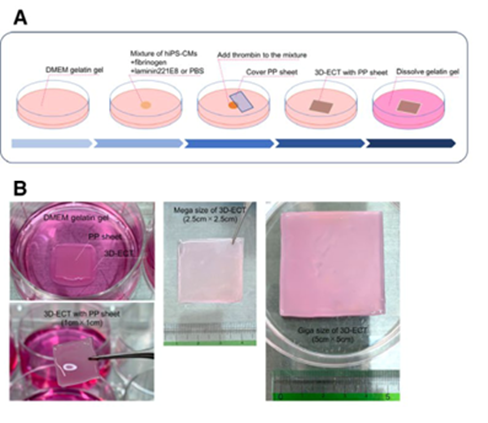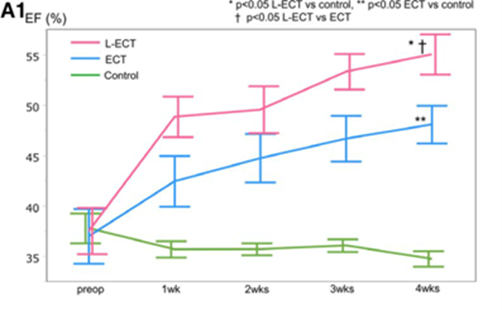Advantage and Core Benefit
- Enables fabrication of large-area, three-dimensional cell sheets with adjustable size and shape.
- Allows for the incorporation of drugs into the cell sheets.
- Simple and cost-effective manufacturing process that can be performed in a short time.
- Demonstrated efficacy in a rat myocardial infarction model.
Background and Technology
In regenerative medicine, the transplantation of three-dimensional cell sheets has gained attention as a method for restoring lost organ functions. However, conventional cell sheet technology requires expensive equipment and lengthy processing times. Fibrin gel, which functions as a biological adhesive, has been considered useful as a scaffold material for cell sheets. However, challenges arise with fibrin concentration control: low concentrations result in poor moldability, while high concentration can cause cellular damage, leading to operational complexity.
In response to these challenges, the researchers have developed a simple and cost-effective method for producing fibrin cell sheets while maintaining fibrin concentration that does not harm the cells. The process consists of the following steps:
- Dropping a fibrinogen solution containing cells or drugs onto a gelatin hydrogel substrate.
- Adding thrombin to initiate the fibrin polymerization reaction.
- Attaching a support membrane, such as a polypropylene sheet, to form a uniform fibrin gel layer.
- Dissolve the gelatin hydrogel substrate to retrieve the fibrin cell sheet.
This method ensures that cells can survive even in a low-concentration fibrin environment while maintaining uniformity and ease of handling. The technique enables easy and rapid stacking of three-dimensional cell sheets. The size and shape of the fibrin cell sheets can be freely adjusted, with successful fabrication of sheets up to 5×5 cm. This technology contributes to the repair and regeneration of the heart, organs, and skin, as well as improved post-transplant function and the promotion of angiogenesis.
 |
Data
- In a rat myocardial infarction model, a fibrin cell sheet containing cardiomyocytes induced from iPSCs (ECT) was transplanted onto the peri-infarct myocardial surface two weeks after inducing myocardial infarction. Echocardiographic assessments were performed weekly for four weeks post-transplantation to evaluate cardiac function (contractility, end-systolic diameter, end-diastolic diameter).
- Significant improvements in cardiac function were observed in the rats transplanted with the fibrin sheets over the four-week period. Furthermore, a fibrin cell sheet containing laminin (L-ECT) exhibited even greater therapeutic effects.
 |
Patent & Publication
Samura, T., et al., J Am Heart Assoc. 2020;9:e015841.
DOI: 10.1161/JAHA.119.015841
Researcher
Dr. Takaaki Samura (The University of Osaka)
Expectations
The University of Osaka seeks collaboration with companies interested in this technology, including:
- Companies developing cell sheets: Integrating this technology into the development of cell sheet and fibrin sheet products, as well as establishing it as a platform technology for cell therapy.
- Companies developing cell-based pharmaceuticals: Incorporating proprietary cell-based therapies into fibrin cell sheets.
Project No.WL-02986


